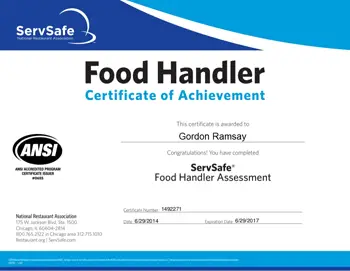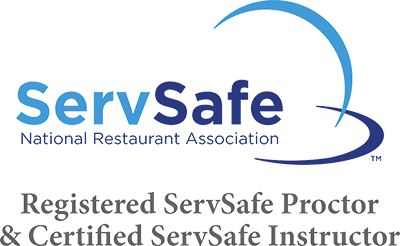Comprehensive Food Handlers Educating for Health and Security
In today's rapidly developing food service landscape, comprehensive food handlers training has actually arised as a crucial component for guaranteeing hygiene and safety and security. By instilling necessary techniques associated with hand hygiene, food storage, and cleanliness, this training not just reduces the risk of foodborne illnesses but additionally enhances conformity with regulatory standards. The implications of such training extend beyond plain compliance; they touch upon public wellness and customer trust fund. Yet, the efficiency of these training programs can differ considerably. What factors genuinely establish their success in fostering a culture of safety?
Importance of Food Security Training

Additionally, food security training aids to guarantee that staff members recognize existing laws and standards, which are necessary for maintaining functional licenses and preventing pricey penalties. Routine training sessions additionally offer as a system for enhancing finest practices, thus minimizing the chance of human error, which commonly functions as a leading root cause of food contamination.
Moreover, investing in food safety training can improve an establishment's track record, as clients increasingly focus on eating experiences that reflect high safety requirements. Such positive steps not just safeguard consumers however likewise add to the long-term success of food services. In recap, extensive food security training is a crucial component of food service procedures, straight affecting both public wellness and service sustainability.
Trick Concepts of Health
Preserving high standards of hygiene is important in any type of food handling atmosphere to stop contamination and make sure the safety and security of consumers. The vital principles of health encompass numerous vital practices that food handlers should continually use.
First, hand health is paramount; food trainers must clean their hands extensively with soap and water prior to and after taking care of food, as well as after using the washroom or touching any potentially contaminated surface areas. Devices and surface areas have to be consistently cleaned up and sanitized to eliminate pathogens. This includes tools, cutting boards, and counter tops, which need to be kept in a clean condition.


Appropriate food storage space is additionally important; raw foods must be stored independently from cooked or ready-to-eat items to stay clear of cross-contamination. servsafe food handler. Additionally, preserving appropriate temperature controls is crucial; disposable things must be kept at safe temperatures to prevent microbial growth
Finally, personal health can not be overlooked. Food trainers need to wear tidy garments, usage hair restraints, and prevent working when ill. By sticking to these key principles of health, food trainers can significantly reduce the danger of foodborne illnesses and promote a more secure eating experience for all customers.
Common Foodborne Diseases
Although numerous foodborne diseases can be avoided through proper hygiene and secure food taking care of methods, they remain a substantial public health and wellness concern. Foodborne microorganisms can bring about a selection of ailments, ranging from moderate intestinal distress to serious complications and also death.
Usual foodborne diseases consist of salmonellosis, triggered by Salmonella microorganisms, commonly connected to Our site undercooked poultry and eggs. Another common ailment is listeriosis, associated with unpasteurized dairy products and ready-to-eat meats, which can be particularly hazardous for pregnant women and immunocompromised people. Norovirus, regularly contracted from polluted food or surfaces, is recognized for its quick spread and ability to create outbreaks in communal setups.
Escherichia coli (E. coli) infection, significantly connected with undercooked hamburger and polluted produce, can lead to severe stomach pains and kidney failure in many cases. In addition, Clostridium perfringens, frequently located in large quantities of food that are incorrectly kept, can cause food poisoning with signs and symptoms showing up shortly after consumption.
Understanding these diseases is essential for food handlers, as understanding can considerably reduce the risk of contamination and secure public health and wellness. Correct education and training are essential parts in combating foodborne diseases.
Best Practices for Food Handling
Effective food taking care of methods are important in avoiding the spread of foodborne ailments. Proper hand health is important; food handlers have to clean their hands extensively with soap and water prior to and after dealing with food, particularly raw meat or fowl. This basic activity dramatically decreases the danger of cross-contamination
Secondly, preserving ideal food storage temperature levels is critical. Perishable products must be saved at or below 40 ° F(4 ° C) to hinder bacterial growth. Additionally, prepared foods ought to be maintained above 140 ° F(60 ° C) till offered.
Finally, making certain tidiness of surface areas and tools is important. Regularly sanitize counter tops, reducing boards, and utensils, especially after preparing raw foods. Use different cutting boards for raw and ready-to-eat foods to better minimize contamination dangers.
Furthermore, when preparing food, it is essential to follow the principle of "initial in, initially out" (FIFO) to manage inventory efficiently and minimize perishing. Always stick and check out to food item tags for risk-free cooking temperatures and dealing with instructions. By applying these finest my explanation methods, food handlers can substantially improve food security and secure public health and wellness.
Executing a Security Culture
Creating a safety society within a food taking care of atmosphere is necessary for promoting a commitment to food safety among all employee. This society stresses the value of food security as a shared duty, motivating employees to focus on health practices consistently.
To apply a security culture, companies must begin by giving detailed training that deals with food handling methods, prospective hazards, and the value of personal health. Training sessions should be interactive and customized to the particular functions of staff participants, ensuring relevance and involvement.
Furthermore, management plays an important role in developing this culture. Monitoring ought to design safe try these out methods and connect the significance of food safety and security frequently. Recognizing and awarding staff members who support safety and security standards can even more enhance these behaviors.
Furthermore, open interaction networks must be established, permitting team to report security problems without worry of repercussion. Normal safety audits and feedback sessions can help determine locations for renovation and reinforce liability.
Ultimately, cultivating a security culture not only enhances conformity with food safety policies however likewise shields public health, fosters worker spirits, and adds to the overall success of the food managing facility.
Final Thought
To conclude, comprehensive food trainers training plays a pivotal role in advertising health and security within food service facilities. By outfitting staff members with crucial expertise about food safety concepts, common foodborne health problems, and finest methods for handling food, such training dramatically minimizes health and wellness risks. Furthermore, cultivating a society of security enhances the facility's track record and lines up with customer assumptions for high safety standards, inevitably contributing to public health security and the total success of the food service industry.
In today's swiftly progressing food service landscape, detailed food trainers training has arised as an essential element for ensuring hygiene and safety and security.Food safety training is critical for maintaining high requirements in food handling and prep work, with studies suggesting that correct training can decrease foodborne ailments by up to 30%. In recap, extensive food safety and security training is an important component of food solution operations, directly affecting both public wellness and business sustainability.

Comments on “How to Improve Your Abilities with ServSafe Certifications for Food Safety Quality”